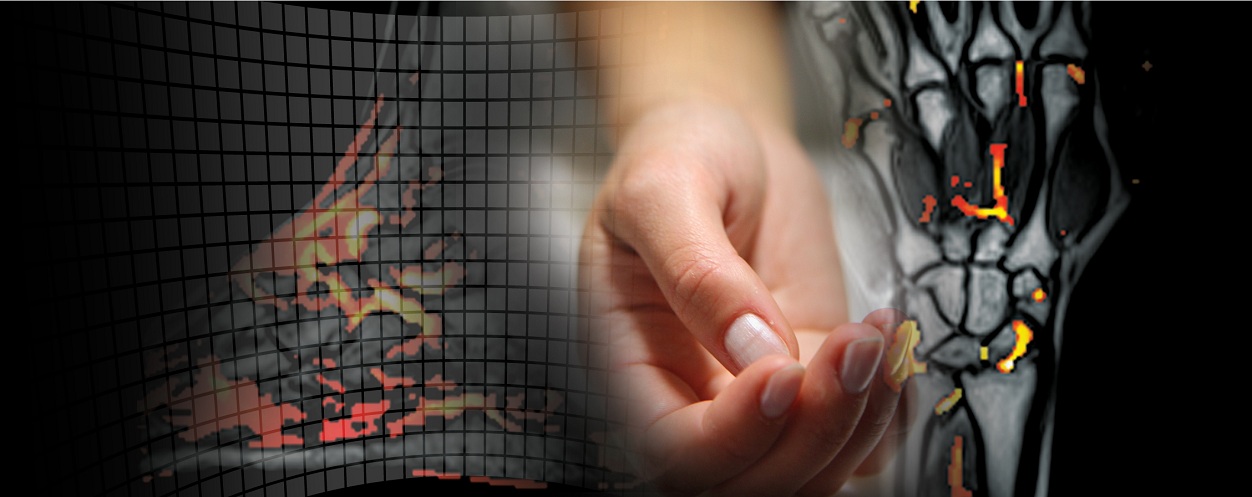

Apremilast Reduces Inflammation in Patients With Psoriatic Arthritis.
Published:
January 13, 2023
Publication:
EULAR 2023 Congress Abstract N°: 2797
Authors:
Mikkel Østergaard, Walter P Maksymowych, Mikael Boesen, Robert G Lambert, Guillermo Valenzuela, Michael Bubb, Olga Kubassova, Jyotsna Reddy, Stephen Colgan, Yuri Klyachkin, Cynthia Deignan, Lihua Tang, Maria Paris, Philip J Mease
Apremilast Reduces Inflammation as Measured by MRI of the Hand in Patients With Psoriatic Arthritis: Primary Results from the Phase 4 MOSAIC Study
Background:
Psoriatic arthritis (PsA) is characterized by inflammatory arthritis, enthesitis, dactylitis, and spondylitis. Apremilast is an oral immunomodulating phosphodiesterase-4 inhibitor approved for the treatment of PsA. The impact of apremilast on objective measures of inflammation and structural progression of PsA has not yet been characterized. Here, we evaluate the efficacy of apremilast 30 mg BID (APR) on inflammation measured by dedicated MRI of the hand.
Objectives:
To evaluate the efficacy of APR on inflammation and imaging outcomes and the safety profile of APR in this setting.
Methods:
MOSAIC (NCT03783026) was a phase 4, multicenter, single-arm, open-label study in patients (pts) with active PsA (≥3 months but ≤5 years since diagnosis, meeting CASPAR criteria for PsA) evaluating APR as monotherapy or in combination with stable methotrexate. Pts were treated with APR for 48 weeks and had MRI of the hand (contrast-enhanced) performed at baseline (BL), Week 24, and Week 48. All images were read and adjudicated by 2 experienced readers blinded to clinical information and time of acquisition. The primary endpoint was change from BL in the composite score of hand bone marrow edema (BME), synovitis, and tenosynovitis in fingers 2–5, as assessed by the PsA MRI Score (PsAMRIS) at Week 24. Total inflammation score, comprised of BME, synovitis, tenosynovitis, and periarticular inflammation in fingers, was also assessed. Structural progression was assessed by the total hand damage score (determined by bone erosion and bone proliferation in fingers 2–5). Subgroup analyses based on BL disease activity as measured
by Clinical Disease Activity Index for Psoriatic Arthritis (cDAPSA) were performed for key endpoints.
Results:
A total of 122 pts enrolled and received APR. Mean age was 47 years, 55% were women, and mean duration of PsA was 1.9 years. The Full Analysis Set (FAS) included 98 pts evaluable for the primary endpoint (having BL and Week 24 data); 4 had major protocol deviations and 94 were evaluable as part of the per protocol (PP) population. The least- squares (LS) mean (95% CI) change from BL in the composite inflammation score of BME, synovitis, and tenosynovitis as assessed by PsAMRIS (FAS) was -2.32 (-4.73, 0.09) at Week 24 and -2.91 (-5.45, -0.37) at Week 48 (Figure). In the PP population, the LS mean (95% CI) change from BL in the composite score at Weeks 24 and 48 indicated a significant reduction of disease activity (Figure). Significant improvements from BL were seen in total inflammation scores (BME + synovitis + tenosynovitis + periarticular inflammation) in the FAS (Figure). The structural outcome indicated by the total hand damage score, including bone erosion, showed no significant change from BL to Week 48 (Figure). Pts also experienced significant improvements from BL in cDAPSA at Weeks 24 and 48 (Figure).
Subgroup analyses based on disease activity at BL showed significant improvements from BL in inflammation in pts with moderate disease activity (ModDA; cDAPSA score >13 to ≤27) and no significant change from BL in total damage (Figure). Though it was insignificant, pts with high disease activity (HDA; cDAPSA score >27) did have improvement from BL in inflammation indices (Figure).
Common treatment-emergent adverse events were diarrhea (33.6%), nausea (12.3%), headache (10.7%), nasopharyngitis (7.4%), and dyspepsia (6.6%). No new safety signals were identified.
Conclusion:
Pts with PsA treated with APR had improvements in both clinical indices and objective MRI indices of inflammation assessed by PsAMRIS in the target hand at Week 24 and Week 48, confirming an effect of APR on clinical and inflammatory manifestations of PsA. Pts with ModDA seemed to have greater improvement from BL in MRI inflammation scores than pts with HDA. No significant structural progression was observed. These results offer important insights on the effect of apremilast in PsA and highlight the value of using MRI and PsAMRIS as measures of inflammatory disease activity and change following treatment.
